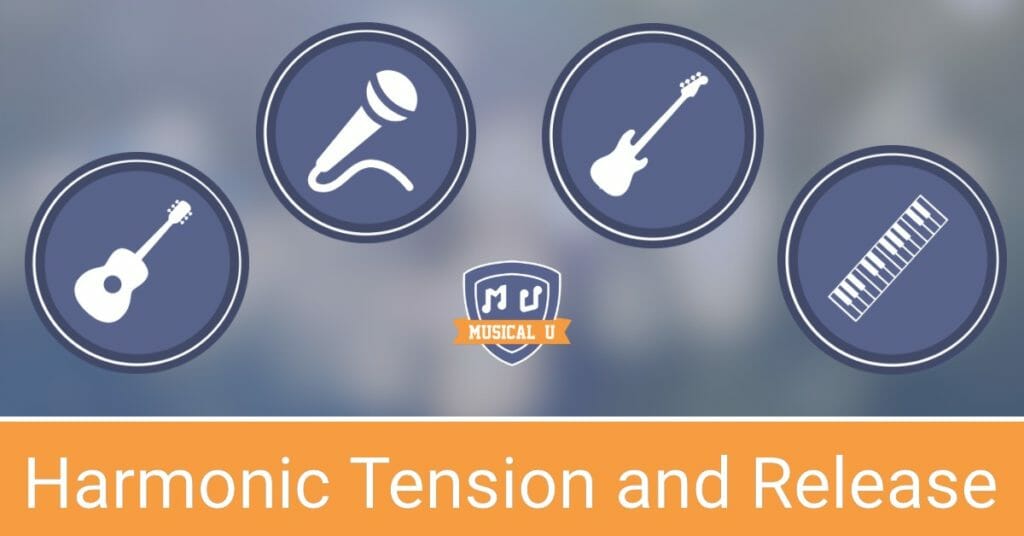Tension and release are everywhere. It’s in how our bodies move, how we breathe, how we swallow our food. These two aspects provide the forward impetus that keeps music moving forward on the “canvas of time” (to quote our Resident Bass Pro, Steve Lawson).
When we are creating our own music through improvisation, understanding tension and release brings our music to life. Otherwise, our solos may sound bland.
While tension and release can be found in many aspects of music, one of its richest manifestations is in the area of harmony, and how our melodies intersect with the harmonic environment set up by chords and chord progressions.
Often, when beginning improvisers first learn to play over chords, they practice hitting the chord tones in their melodies. That can produce a “safe” improv, where everything blends and works well. But without some tension and release, there’s a risk of the music sounding static, bland, and boring.
This tension and release can be produced with chord tones through rhythm, dynamics, and other musical dimensions. But even more magic happens when you step out of the box and explore pitches beyond the chords – or, as Resident Guitar Pro Dylan Welsh shows us, even beyond the scale!
Yes, it’s a risk, but a risk worth taking. And the more you explore beyond the chord tones, the more you’ll find that all the “other” notes have varying degrees of tension that provide new and wondrous shades of harmonic coloration to your musical expression.
In this month’s Instrument Packs, Musical U’s Guitar, Bass, and Piano Pros open your eyes and ears to the possibilities of harmonic tension and release through fun and challenging improvisation exercises.
Piano
Good vs. evil, dark clouds with silver linings, sweet & sour… so many great things in our lives are accompanied by their opposite. But it’s the bad that makes the good feel so wonderful – we experience this polarity every day of our lives and it’s also within music. In music, we have different words for it: harmony and dissonance, or as talked about in this Resource Pack, tension and release.
In this resource pack, Guest Piano Pro for piano, Ruth Power, teaches how to grow your awareness and skills through improvisation:
Including:
- How to direct your tension to create the most satisfying release.
- Eight powerful exercises that explore the nuances of non-chord tones and the varying ways they resolve to chord tones.
- MP3 demo and backing tracks that illustrate and provide practice opportunities for each exercise.
- Bonus MP3 “Level Up” backing tracks in every major key.
Tension sounds like something we really wouldn’t want in our music, but tension is the very reason that the release is so sweet! Ruth shares some techniques we can use in improvisation to easily create moments of tension and release. We can create an improvisation on the fly that is intentional, that pushes all the right buttons in yourself and your listeners, and gives meaning to the music.
Guitar
Using tension and release deliberately in your improvising provides the listener with a sense of satisfaction and really helps to take them on a journey through your solo. Once you understand the basic concept, you can apply this to various degrees on the guitar.
Resident Pro Dylan Welsh demonstrates different kinds and levels of harmonic tension, and how to drive them forward to release:
Including:
- How to get the most out of scale and chord tones to really take the listener on a journey.
- How to use various amounts of chromatism to increase the tension of your solo, thus increasing the feeling of satisfaction from the release of tension.
- How to play all the wrong notes and still sound good.
- Bonus: using rhythm, rather than note choice, to introduce additional tension into your solo.
- MP3 backing tracks to hone in on your improvisation skills with harmonic tension and release.
This kind of practice is very, very structured and targeted. It may feel like work, but if you put the time in, it will make a massive difference in your improvising (as well as in all other aspects of your guitar playing).
Bass
Steve Lawson, our Resident Pro for bass, guides us through a musical world of intriguing opposites –
- tension and release
- question and answer
- consonance and dissonance
- back and forth
- moving away and coming back
- expectation and confirmation
- ambiguity and directness
In the process, we will learn how harmonic tension and release fit within the grand scheme of music:
Including:
- How harmonic tension and resolution can be top-down or bottom-up.
- The special role of bass players in determining the harmony.
- What basslines do to the harmony.
- What melodies do with the harmony.
- Ear-opening exercises that demonstrate the principles of tension and release for bass players.
- Custom MP3 tracks, TAB, and scores for each exercise.
Whether playing basslines or melody, bass players exert a powerful control over the harmonic structure of the music. Steve will show you how to wield this power with wisdom and authority!
Coming up next month…
More fascinating, fun, and growthful resources from Musical U’s Resident Pros.
Interested in getting access to these resources and much more, with an Instrument Pack membership? Just choose that option during checkout when you join Musical U, or upgrade your existing membership to get instant access!







